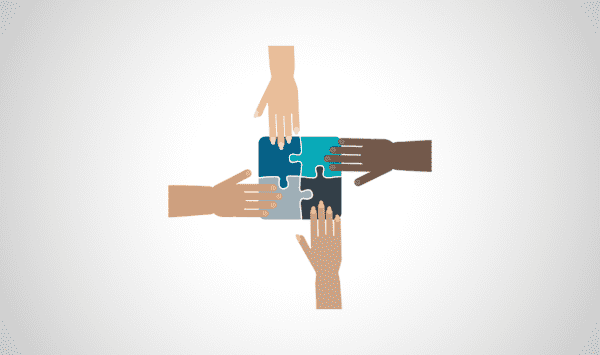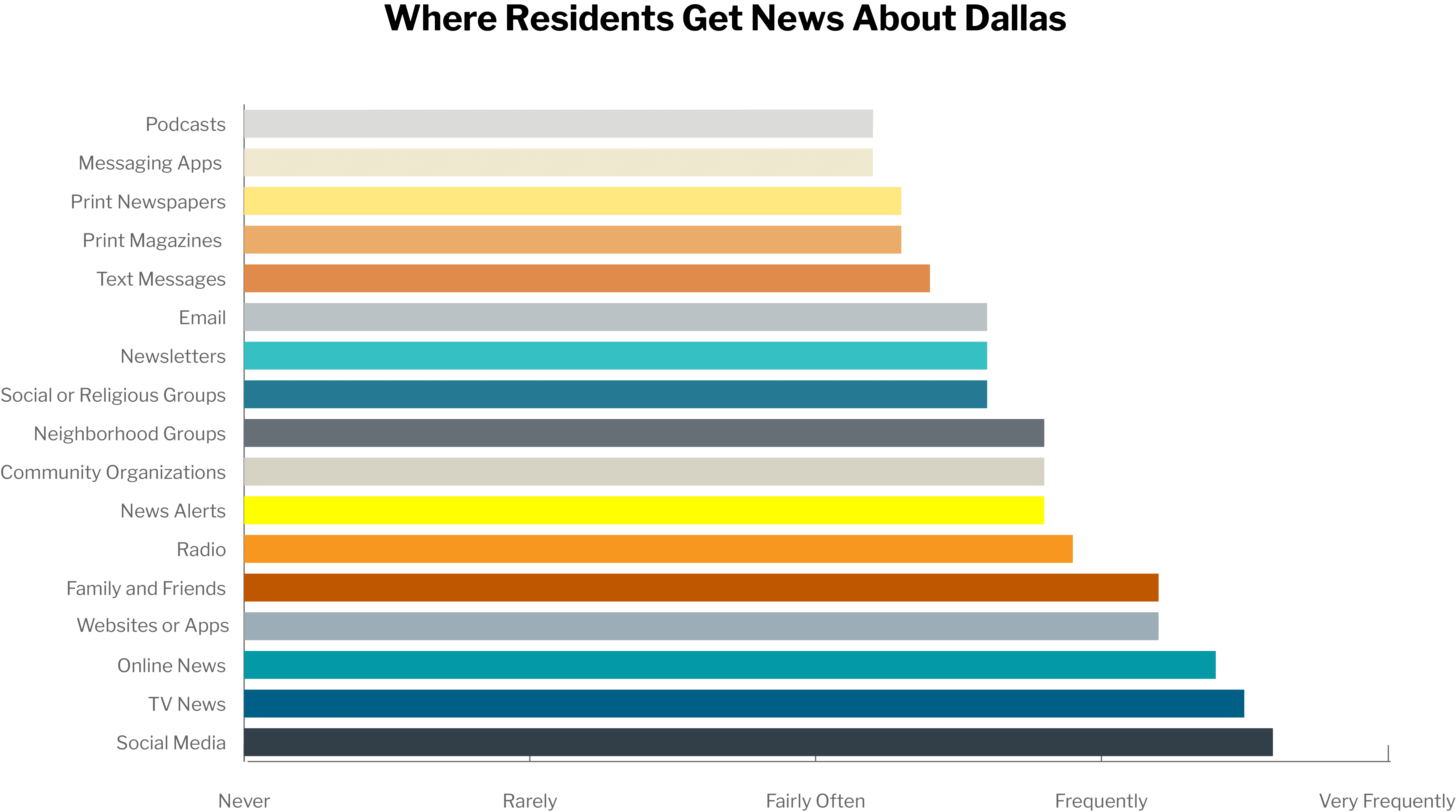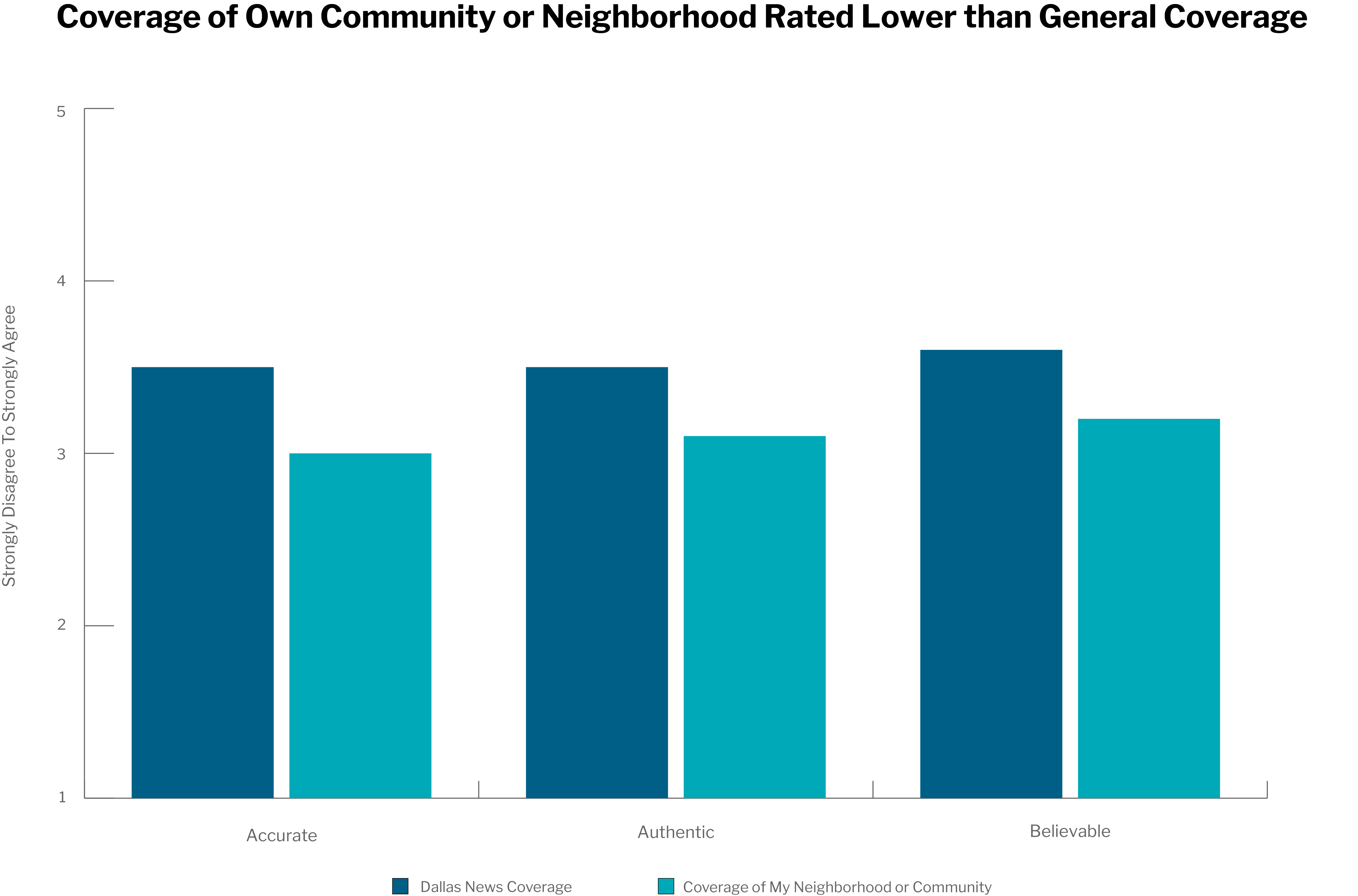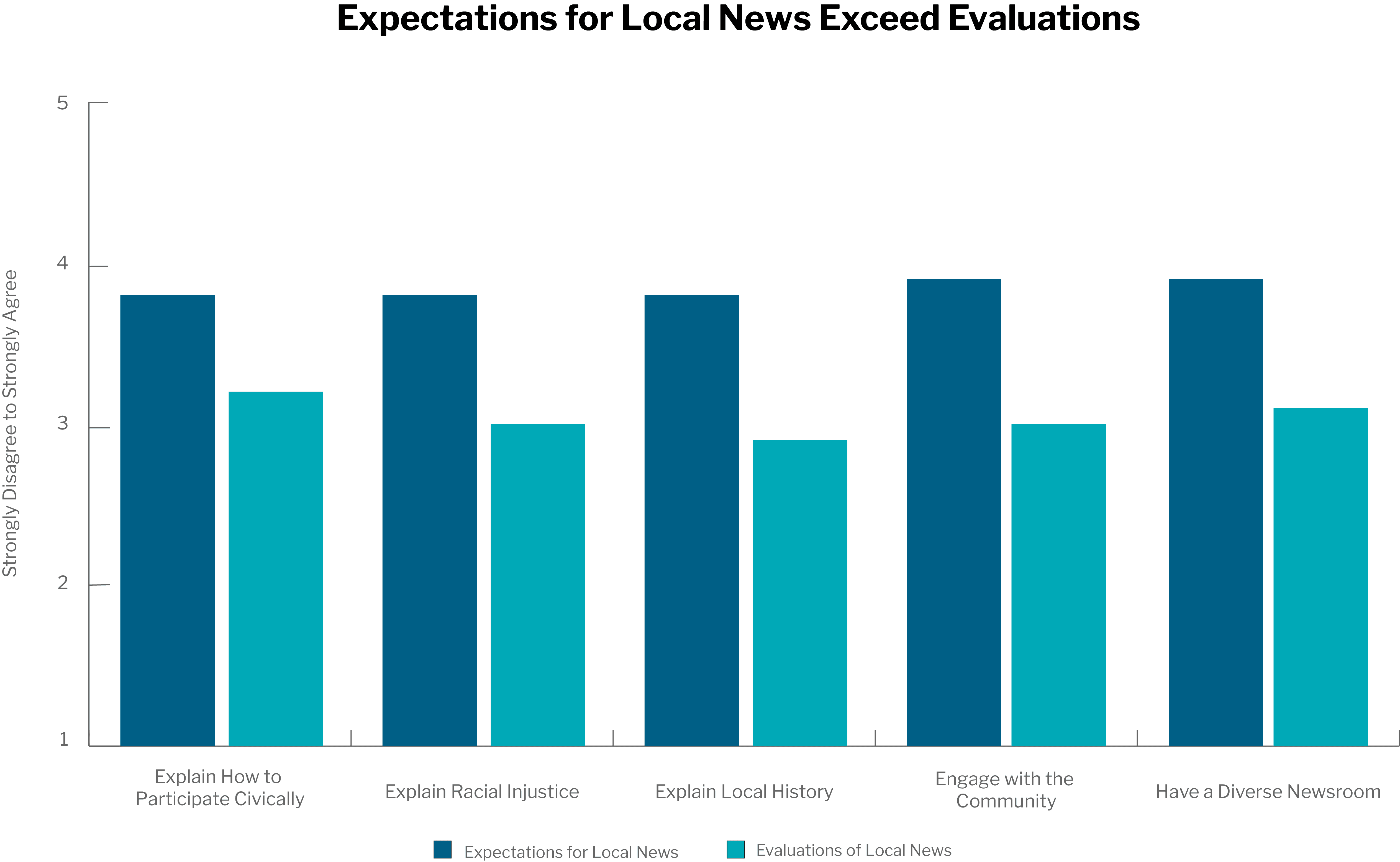
SUMMARY
The Center for Media Engagement partnered with the Dallas Free Press to explore how Dallas residents — particularly those in the disinvested neighborhoods of West Dallas and South Dallas — perceive local media and how they think that media can better serve their communities.
Those participating in the study generally felt that news coverage of their communities was lacking, did not accurately represent the area, and did not meet expectations. These findings helped reveal four approaches journalists anywhere can take to help bridge the divide between the media and local residents.
THE PROBLEM
Historically, certain communities, such as Black and Hispanic people, are under-represented in the news media.1 Center for Media Engagement research has shown that Black Americans2 across the country and people living in the West and South Sides of Chicago3 feel the media under-represents or poorly represents them. Analysis of Chicago media coverage4 supports these perceptions.
For this project, the Center for Media Engagement teamed up with the Dallas Free Press, a nonprofit news source, to explore how Dallas residents perceive the local media and how they think the media could better serve their communities. The study focuses on the neighborhoods of West Dallas and South Dallas, two divested communities — or communities that lack resources because government and society have not invested in them. West Dallas has a predominantly Hispanic population, and South Dallas has a largely Black population. Dallas Free Press launched in 2020 to focus community journalism efforts in these two Dallas neighborhoods and commissioned this study to inform that work, as well as to highlight Dallas news consumption practices and information needs to illuminate a new local media collaborative. Our findings offer insights for local newsrooms across the United States.
KEY FINDINGS
- Local news sources
Social media and TV news were the primary local news sources for Dallas-area residents, although more than a third of participants said they never consume news about Dallas. Specific top sources were Facebook; The Dallas Morning News; WFAA-TV, the ABC affiliate; and KDFW, the FOX affiliate. Facebook neighborhood groups and news organizations’ Facebook pages were noted as particularly helpful. - Local news access
Mobile was the preferred method for accessing local news for Dallas-area residents we surveyed, followed by TV. Word of mouth was a powerful means for people to learn about local news, and some participants felt comfortable going directly to neighborhood organizations or local officials for news. - Concerns about local news coverage
Many participants had never communicated with a journalist, and a third of participants had never seen one engaging with people in their neighborhood or community. They felt coverage of their area was too negative, sensationalized their community, and left out key information. - Expectations for news not met
Participants rated coverage of their own neighborhood or community as significantly less “accurate,” “authentic,” and “believable” than general coverage by Dallas news outlets. For the most part, they felt that coverage of their communities and neighborhoods did not meet expectations.
IMPLICATIONS
Our findings helped reveal the following four approaches journalists can take to help bridge the divide between the media and local residents:
1. Develop relationships in the community
Get to know the community and neighborhood organizations and spend time in the area, rather than just dropping in to cover bad news.
2. Be fair and consistent
Ensure certain neighborhoods and communities aren’t covered differently than others by taking steps to be fair and consistent. Participants felt that not all areas were covered the same way, particularly areas that were less affluent and more diverse in terms of race and ethnicity. They suggested news outlets not specify the race of a Black suspect if they would not specify race for a white suspect. They also urged journalists to quote people who live in the community, not just those who volunteer there and live elsewhere.
3. Be a community resource
Provide more information about community resources, such as where to get help for local problems or events happening in the area. Participants felt news about their neighborhood or community was often not reflected in coverage.
4. Show empathy
Focus more on the human perspective when telling difficult stories, such as stories about unaccompanied minors crossing the border. Participants urged journalists to imagine the situation was happening to someone in their family and tell the story while keeping those feelings in mind.
FULL FINDINGS
The Center for Media Engagement surveyed residents from the Dallas area and interviewed a subset of those surveyed from the West Dallas and South Dallas neighborhoods. Interview participants are identified by first name pseudonyms they chose. Our findings reflect both the survey and interviews.
How Dallas Residents Get Local News
Nearly half (47%) of participants reported consuming some form of news at least daily, with 27.8% consuming news more than once a day, 20.6% once a week, and 4.7% very little or not at all. More than a third (44.3%) had never communicated with a reporter in any way, and 32.6% had never seen a reporter engaging with the community at a local event.5
When participants rated how frequently they used 17 possible local sources to get news about Dallas,6 social media and TV news were tied for the top spot, followed by online news, family and friends, and websites and news apps. Messaging apps like WhatsApp, podcasts, and print newspapers and magazines were least commonly used.
We asked participants to select which of these 17 sources was their top source for local news and to name a specific outlet or platform for that source. For example, if they reported that TV news was their top source, they were to name a specific station, or if they noted that social media were their top source, they were to name a specific platform. The top response was Facebook (mentioned 46 times); followed by The Dallas Morning News (29 mentions); and then a tie between WFAA-TV, the ABC affiliate, and KDFW, the FOX affiliate (24 mentions apiece).7 Then participants selected the local source they used second most frequently from the 17 sources and named a specific outlet or platform for that source. Facebook was again the top mention (46), followed by The Dallas Morning News (31 mentions).

News Consumption from Social Media
In total, 32.4% of participants said they never used social media for news about Dallas.8 Of those who did, Facebook was by far the top source, followed by YouTube and Instagram.

Neighborhood Facebook groups and news organization’s Facebook pages were particularly helpful for people, according to interview participants. “Facebook will tell you everything,” noted Martha, 61, who is in a Facebook group for her neighborhood. Shelly, 29, also found Facebook useful. “I definitely relied on Facebook within the past year to just kind of inform myself on the politics,” she said. “So if I’m driving, and I do see those posters or … the lawn signs for the different candidates, I’ll take a picture of them, go home and research it.”
News Consumption from Mobile Phones
In total, 37.6% of participants said they never consumed news about Dallas.9 Of those who did, the mobile phone was the most common way to get news, followed by TV. Print was the least common method.

News Consumption by Word of Mouth
While word of mouth was not the most frequently used method, interview participants noted it was a powerful method for learning about local news. “If I want to know something, I go to the people to find out what’s happening,” explained Michaela, 60. “Oh, okay, this is happening in South Dallas, oh, wow. … Let’s see how we can help.” Leanne, who didn’t give an age, shared a similar sentiment, explaining that she relies on a neighbor to keep her updated: “I have a neighbor, and she’ll kind of tells me, you know … This man died.”
Neighborhood groups and local officials play a key role in news sharing, as people feel comfortable going directly to them to find out what’s going on. “I communicate with the city planning commissioner,” noted Casey, 36. “We know each other on a first-name basis. We talk, like, once or twice a month. … The councilman, he and I talk once or twice a month. … I’m, like, getting alerts and emails and people texting me, like, ‘Hey, did you hear about such and such?’”
Concerns that News Coverage is Lacking and Unbalanced
Participants rated coverage of their own neighborhood or community as significantly less “accurate,” “authentic,” and “believable” than Dallas news coverage in general.10

Several interview participants described coverage of their neighborhoods and communities as too negative and unbalanced, with little attention given to positive news. “They think we’re the gun and knife club,” explained Bakhtin, 65. “… If it bleeds, it leads.”
Participants blamed sensationalism and bias for the problematic coverage. “Every once in a while … you’ll get a good story … that’s accurate, and that really reflective of the community, you know,” Donovan, 47, said. “…The problem is that one story is outshined by a thousand … catchy stories, you know.” Leanne said she felt the media ignores news in her neighborhood because it’s not affluent. “They think that we’re poor. We’re all poor down here, you know,” she said “… Somebody goes around here and shoots somebody or something. We don’t see it in the news.”
News Topics of Interest
When given nine topics to choose from, participants picked crime and law enforcement; economic issues; and housing, zoning, and land use as the most important local news topics.11 They were also asked to rate how well Dallas media did in covering those topics. Another question asked participants to identify two news outlets they had recently used and to then rate how well those outlets covered their neighborhood. When comparing the results of these two questions, participants rated Dallas media coverage of their top issue more favorably on average than they rated the general coverage of two local news outlets they had used recently.12 They also rated interest in event coverage as significantly higher than interest in coverage of Dallas city government, schools, their neighborhood, community groups in their neighborhood, or racial injustice.13
Expectations Not Met
Participants’ evaluations of local news coverage did not live up to their expectations. Across five topics, their expectations of what local news outlets should do were significantly higher than their evaluations of what local news outlets are actually doing.14

Ways to Improve Coverage
Interview participants suggested four ways news organizations can improve coverage of their communities and neighborhoods.
Develop Relationships in the Community
Participants urged journalists to connect with neighborhood and community organizations and residents to a greater extent, rather than only showing up when news breaks. As Anne, 32, put it: “Not just, like, ‘All right, here, here’s a camera, here’s a microphone,’ like, ‘Give me a sound bite,’ and then I’m gone. But maybe trying to just really connect. … So that, you know, it feels like a relationship, not just exploitation.”
Michaela, 60, shared a positive example of how journalists might do this. She met a journalist who asked for her phone number. Now the journalist calls regularly, Michaela said, and asks, “‘What’s happening? What story, what do I need to do?’”
Be Fair and Consistent
Several participants suggested journalists could use more neutral language when describing contentious situations. “If you’re going to describe it,” noted Casey, 36, “the description should be a, like, legal description without any words that are meant to evoke a certain emotion or any adjectives that might be a little too subjective.”
Another suggestion, participants said, was that journalists should not include race in stories in one neighborhood but not in another, particularly when describing suspects in crime stories. Journalists should also develop multiple sources in a neighborhood or community, rather than letting one voice be the only one heard from a particular area. “It’s just like they try to get the roughest-looking person to put … on TV to say what’s going on,” said Shugg, 61.
Be a Community Resource
Participants suggested local news outlets provide more information about community and neighborhood events and resources, such as where to take a GED review course. Some participants recommended that local news help the public – particularly those new to Dallas – get connected to their own community. “How we could get better connected to the community, especially when you don’t have roots here?” asked Yolanda, 32.
Show Empathy
Participants urged journalists to show more empathy when reporting on difficult stories and be gentle in their questioning. “Have a heart,” Shugg, 61, suggested. “Pretend that it’s somebody in your family that you loved that you’re interviewing.” Yvonne, 40, said she realizes journalists need to be neutral, but they can still show compassion when “something tragic has happened.”
To do this, participants encouraged journalists to focus on sources’ humanity. “We see it now with the children … crossing the border,” explained Destiny, 38. “We’re taking that … human aspect out of these kids. These are somebody’s baby.”
METHODOLOGY
To gain survey participants, the Dallas Free Press distributed survey links to various community organizations and stakeholders to disseminate, and volunteers recruited participants. Participants had to be at least 18 years old and reside in the Dallas area.15 A total of 48216 people participated in the survey from late December 2020 to May 17, 2021. A total of 83% of participants completed the survey in English and 17% in Spanish. A Spanish- speaking volunteer for the Dallas Free Press translated the survey into Spanish.
Participants answered questions about their perceptions of the news media in the Dallas area. Participants from South Dallas and West Dallas17 were invited to be interviewed to discuss their feelings about the Dallas news media in-depth, and 116 people indicated they were willing. A total of 16 people were interviewed, and interviews lasted about an hour each.18 They were conducted via Zoom or by telephone and were recorded. The recordings were transcribed, and a researcher read through the transcriptions to find commonalities in what people were saying.

Suggested Citation
Duchovnay, M. and Masullo, Gina M. (July, 2021). How to connect with disinvested local news audiences. Center for Media Engagement. https://mediaengagement.org/research/how-to-connect-with-disinvested-local-news-audiences
- Campbell, C., LeDuff, K., Jenkins, C. D., & Brown, R. A. (2012). Race and news: Critical perspectives. Routledge; Lamb, Y. R., & Byerly, C. M. (2019). Kerner @ 50 looking forward; looking back. Howard Journal of Communications, 30(4), 317–331. [↩]
- Kilgo, D. K., Wilner, T., Masullo, G. M., & Bennett, L. K. (November, 2020). News distrust among Black Americans is a fixable problem. Center for Media Engagement. https://mediaengagement.org/research/news-distrust-among- black-americans [↩]
- Van Duyn, E., Jennings, J., & Stroud, N. J. (2018, January). Chicago news landscape. Center for Media Engagement. https://mediaengagement.org/research/chicago-news-landscape [↩]
- Stroud, N. J., Curry, A., Murray, C., & Kim, Y. (2020, August). Chicago media mapping. Center for Media Engagement. https://mediaengagement.org/research/chicago-mediamapping [↩]
- Ratings were on a 0 (never) to 4 (very frequently) scale. The prompts were: “Please rate how frequently you have done the following: Communicated with a local news reporter in any way” and “Been to an event where local reporters were engaging with the community.” [↩]
- Ratings were on a 0 (never) to 4 (very frequently) scale. The prompt was: “We are interested in how you get news and information about Dallas. For each of the following, rate how frequently you use it to get news and information about Dallas.” [↩]
- Participants were prompted to write in one specific source, but some wrote in several. In those cases, the first source mentioned was used in our analysis. [↩]
- Ratings were on a 0 (never) to 4 (very frequently) scale. The prompt was: “Please indicate how frequently you use the following social media platforms to get news and information about Dallas.” [↩]
- Ratings were on a 0 (never) to 4 (very frequently) scale. The prompt was: “Please indicate how frequently you use the following technology to get news and information about Dallas.” [↩]
- “Accurate,” “authentic,” and “believable” were used because research has shown these three adjectives provide a reliable measure of news credibility. Appelman, A., & Sundar, S. S. (2016). Measuring message credibility: Construction and validation of an exclusive scale. Journalism & Mass Communication Quarterly, 93(1), 59–79. Both ratings were on 1 (strongly disagree) to 5 (strongly agree) scales. The general news prompt was: “Generally speaking, to what extent do you agree or disagree that the following words describe Dallas news outlets?” The prompt regarding neighborhood or community coverage was: “To what extent do you agree or disagree with the following statements about how Dallas news outlets cover your neighborhood or community? The local news media are…” [↩]
- The topics were: crime and law enforcement; economic issues; education; the environment; housing, zoning, land use; politics; racial injustice; health issues; and other. Participants could write in a topic for other, although few did. Then they rated “how good a job” the Dallas media did of covering that topic. They had the option to choose “very poor,” “poor,” “acceptable,” “good,” or “very good.” [↩]
- Participants were prompted to type in a name of a local news outlet they had used in the past 30 days, and then they rated “how good or poor of a job” it did covering their neighborhood. They had the option to choose “very poor,” “poor,” “acceptable,” “good,” or “very good.” Then they were prompted again to write in the name of a second local news outlet they had used in the past 30 days, and rate it the same way. [↩]
- Ratings for each were on a 1 (strongly disagree) to 5 (strongly agree) scale. Average scores for all ratings were statistically indistinguishable, except for events (M = 4.1), which was significantly greater than all the other means. [↩]
- Participants rated the extent to which they “agree or disagree that the local news media should be” covering five areas, and then they rated “how successful the news media in Dallas are” at covering the same five topics. Both sets of ratings were on a 1 (strongly disagree) to 5 (strongly agree) scale. Differences were tested using a series of paired t tests, comparing each expectation with the corresponding evaluation. [↩]
- The University of Texas at Austin’s Institutional Review Board approved this project November 11, 2020. We determined whether people were from the Dallas area by asking them to report their ZIP code, and including data from those from the following ZIP codes: 75006, 75063, 75070, 75089, 75104, 75116, 75126, 75137, 75201, 75202, 75203, 75204, 75206, 75207, 75208, 75209, 75210, 75211, 75212, 75214, 75215, 75216, 75217, 75218, 75219, 75223, 75224, 75226, 75227, 75228, 75229, 75230, 75231, 75232, 75233, 75235, 75236, 75238, 75240, 75241, 75243, 75244, 75247, 75248, 75249, and 75251 [↩]
- A total of 801 people initially took the survey, but data were not analyzed for those who completed less than 10% of questions (n = 264), who did not consent or indicate they were at least 18 years old (n = 24), or who do not live in the Dallas area (n = 31). This resulted in N = 482. [↩]
- ZIP code for West Dallas was 75212; for South Dallas it was either 75210 or 75215. [↩]
- Participants were entered into a random drawing to win one of 10 $50 gift cards for completing the survey. Each interview participant received a $30 gift card after completing the interview. [↩]



